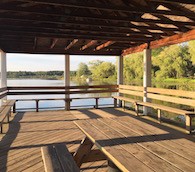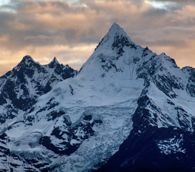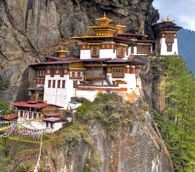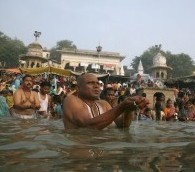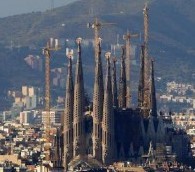Tag: Spiritual Travel
Road Trip to the Spiritual Assembly
by Nancy Davis Kho | 01.26.16 | 12:18 PM ET
When her Aunt Noonie needed company on an annual pilgrimage, Nancy Davis Kho tagged along. Just how "woo-woo" would things get?
In the Abode of the Gods
by Jeffrey Tayler | 07.10.13 | 11:22 AM ET
Jeffrey Tayler treks a Buddhist pilgrimage route through China's remotest, high-altitude domains
Video: Lisa Napoli in Conversation with Eric Weiner
by Jim Benning | 05.18.12 | 2:01 PM ET
World Hum contributors Lisa Napoli and Eric Weiner spoke in front of a live audience recently in Santa Monica. Napoli, of course, is the author of “Radio Shangri-La,” about her experience in Bhutan. Weiner wrote “The Geography of Bliss” and “Man Seeks God.” Their wide-ranging discussion touched on Bhutan, happiness, authenticity and spirituality, among other things. This 30-minute video has some highlights.
Interview with Gideon Lewis-Kraus: ‘A Sense of Direction’
by Frank Bures | 04.25.12 | 10:07 AM ET
Frank Bures talks to the author about pilgrimage, authenticity and traveling in a world of infinite choices
Into Sacred Air
by Lisa Napoli | 04.10.12 | 11:17 AM ET
In an excerpt from "Radio Shangri-La," Lisa Napoli makes the climb to Bhutan's Taktsang Monastery
Interview with Lisa Napoli: ‘Radio Shangri-La’ in Bhutan
by Jim Benning | 04.10.12 | 11:16 AM ET
Jim Benning asks the author about her memoir and how the Himalayan kingdom changed her
Video: Eric Weiner on his new Book, ‘Man Seeks God’
by Jim Benning | 01.30.12 | 1:03 PM ET
We recently published The Inner Nightclub of Everlasting Joy, an excerpt from Eric Weiner’s new book, Man Seeks God: My Flirtations with the Divine. Here’s Weiner discussing the book and his travels with Lisa Napoli earlier this month at a Live Talks Los Angeles event. It’s an engaging, humor-filled conversation.
Eric Weiner in conversation with Lisa Napoli from Ted Habte-Gabr on Vimeo.
The Inner Nightclub of Everlasting Joy
by Eric Weiner | 01.09.12 | 5:52 PM ET
In an excerpt from his book "Man Seeks God," Eric Weiner explores Buddhism in Kathmandu
Rebuilding the Bamiyan Buddhas
by Eva Holland | 07.27.11 | 5:16 PM ET
The famous Afghan statues were demolished by the Taliban in 2001. World Hum contributor Joanna Kakissis reports on the painstaking rebuilding process for NPR:
Up to half of the Buddha pieces can be recovered, according to Bert Praxenthaler, a German art historian and sculptor, who has been working at the site for the past eight years. He and his crew have sifted through 400 tons of rubble and have recovered many parts of the statues along with shrapnel, land mines and explosives that were used in their demolition.
But how do you rebuild the Buddhas from the rubble?
“The archaeological term is ‘anastylosis,’ but most people think it’s some kind of strange disease,” said Praxenthaler.
For those in the archaeology world, “anastylosis” is actually a familiar term. It was the process used to restore the Parthenon of Athens. It involves combining the monument’s original pieces with modern material.
(Via @juliaindc)
‘Europe’s First Travel Guide’ Missing From Santiago de Compostela Cathedral
by Michael Yessis | 07.07.11 | 6:33 PM ET
The Codex Calixtinus was reported missing Wednesday by distraught staff at the Santiago de Compostela Cathedral. The 12th century illustrated manuscript was “compiled as a guidebook for medieval pilgrims following the Way of Saint James,” according to the BBC.
This is the oldest copy of the manuscript and is unsaleable on the open market.
Only a handful of people had access to the room in which it was kept.
This edition of the Codex Calixtinus is thought to date from around 1150.
Its purpose was largely practical—to collect advice of use to pilgrims heading to the shrine there. It also included sermons and homilies to St James.
The Guardian adds:
The local Correo Gallego newspaper reported that distraught cathedral staff spent hours searching for the manuscript before contacting police late that night.
“Although security systems have been improved considerably it is true to say that they are not of the kind one might find in a bank or a well-protected jewellers,” the newspaper reported.
Only five security cameras were used to watch the archive area, according to the newspaper, and none were pointing directly at the safe where the priceless manuscript was stored.
‘Travel Makes You a Buddhist’
by Michael Yessis | 12.09.10 | 2:59 PM ET
Matt Gross has lost many things on the road: a waxed-cotton newsboy, umbrellas, his security blanket. Here’s what he’s learned from the disappearing objects:
Recently, I wrote about how you sometimes need to be a Zen Buddhist to survive the discomforts of travel. Well, it works the other way, too. Travel makes you a Buddhist, teaching you that attachments are, all too often, only temporary. A scarf left on a Portuguese beach, a new Tunisian friend whose e-mail address proves unreadable—they come and they go.
But of course, they never go completely. We remember them: how gently they caressed our neck—the scarf, I mean—and they survive, like all the really important things that happen to us when we travel, as memories.
The Hajj, in Photos
by Eva Holland | 11.16.10 | 2:12 PM ET
The annual pilgrimage to Mecca kicked off this week. The Big Picture has an absolutely stunning photo essay from the event.
Photo You Must See: Prayers in the Yamuna
by World Hum | 11.08.10 | 1:36 PM ET
Hindus pray in the Yamuna River in Allahabad, India, during the Bhai Dooj festival, which celebrates the bond between brothers and sisters
Barcelona’s Sagrada Familia Consecrated After 128 Years
by Eva Holland | 11.08.10 | 1:03 PM ET
The Pope consecrated the Gaudi-designed church as a Basilica yesterday. The building is still unfinished—it’s been under construction since 1882—but the consecration means that daily masses can now be held in the main nave. If tourist entry fees remain steady, it’s hoped that the Sagrada Familia will be complete by 2026.
New Travel Book: ‘100 Journeys for the Spirit’
by Eva Holland | 10.25.10 | 12:19 PM ET
The new guidebook rounds up 100 destinations that feed the soul. Twenty-five of those spots get write-ups from well-known travel writers, poets and novelists, including Pico Iyer, Jan Morris and Paul Theroux. The Telegraph features several excerpts from the book—here’s Pico Iyer, in the foreword:
We all know how we can be turned around by a magic place; that’s why we travel, often. And yet we all know, too, that the change cannot be guaranteed. Travel is a fool’s paradise, Emerson reminded us, if we think that we can find anything far off that we could not find at home. The person who steps out into the silent emptiness of Easter Island is, alas, too often the same person who got onto the plane the day before at Heathrow, red-faced and in a rage.
Yet still the hope persists and sends us out onto the road: certain experiences can so shock or humble us that they take us to places inside ourselves, of terror or wonder or the confounding mixture of them both, that we never see amid the hourly distractions and clutter of home.
They slap us awake and into a recognition of who we might be in our deepest moments.
Spiritual Tourism Struggling in Sedona
by Eva Holland | 10.22.10 | 12:39 PM ET
The New York Times’ Mark Lacey reports from Sedona—“Arizona’s New Age mecca,” as World Hum contributor Laurie Gough calls it—where visitors numbers are way down. Here’s Lacey:
Nobody is sure exactly what is keeping people away from Sedona’s four vortexes, swirling energy sources emanating from the earth, but the effects are clear: far fewer crystals are being bought, spiritual tours taken and treatments ordered, from aura cleansings to chakra balancings.
That an earthly power—the economy—is a culprit is not in doubt. But some do not discount the effects of an awful incident from a year ago that put Sedona’s New Age community in a bad light and that, to some degree, still lingers, despite efforts by metaphysical people to cast it away.
The rest of the story delves into the impact of that incident last year, when three tourists died in a sweat lodge ceremony. It’s a chilling read.
Illegal Pumping Threatens Angkor Wat
by Eva Holland | 09.28.10 | 4:35 PM ET
The Guardian’s Ben Doherty reports from Siem Reap, where the Angkor Wat temple complex is facing yet another threat. Doherty explains:
Unchecked development, and the widespread, unregulated pumping of groundwater throughout Siem Reap city, has raised concerns that the temples, including the world’s largest religious monument, Angkor Wat, could crack or crumble if too much water is drained away.
The temples and towers of the 402-square-kilometre Angkor site sit on a base of sand, kept firm by a constant supply of groundwater that rises and falls with the seasons, but which is now being used to supply a burgeoning city.
With the number of visitors to the northern Cambodian province approaching 2 million a year, increasing pressure is being put on the scarce water resource.
Thousands of illegal private pumps have been sunk across the city, pulling millions of litres of water from the ground each day.
There’s a report in the works that is expected to outline some possible water solutions for the area.
A Tourist Goes to Church in Harlem
by Eva Holland | 09.27.10 | 2:50 PM ET
Slate writer Jeremy Stahl set aside his discomfort “at the prospect of joining other underdressed white gawkers observing how ‘locals’ pray” and headed north of 96th St. in Manhattan on a Sunday morning. The resulting dispatch is a thought-provoking read. Here’s Stahl setting the scene at Greater Highway Deliverance Temple:
When the music started, the usher who had greeted us began dancing up and down the aisle. The congregation stood up and started to clap and sway. One tourist pantomimed the drumming and imitated the dancing in what looked like an attempt to impress two female friends. The choir performed “I Came To Praise the Lord,” and the lyrics—“I don’t know what you came to do, I came to kneel and pray”—stung almost like a collective rebuke. At one point, a church leader declared the “visitor” count for the day’s service at 147, listed the represented countries, and told us “thank God for each and every one of you”—even, I suppose, the dozing Japanese woman to my left.
When we were back on the bus, our tour guide, Sheila, asked if anyone had any questions. There was just one: “They weren’t offended?”
Beyond the Separation Wall
by Alicia Imbody | 06.07.10 | 12:36 PM ET
Could a late night of Arak and hookah prompt Hasam to open up about life as a young Palestinian? Alicia Imbody wanted to find out.
Holy Week Around the World
by Eva Holland | 04.05.10 | 1:58 PM ET
The Big Picture has another stunning photo essay, this time of Easter celebrations from Afghanistan to Guatemala.
- « Prev Page
- Next Page »
